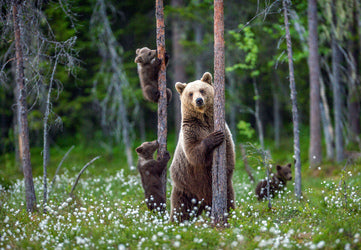Four Basic Strategies for Staying Clear of Wild Animals

You can anticipate seeing great views when you go on your next wilderness adventure. However, with wild spaces come wild animals—usually when you least expect them! Knowing how to avoid a snake, bear, moose, or another dangerous animal will help reduce the possibility of injury or death to you or the animal. We want you to come home safe, so we put together a few tips to help you avoid any troublesome encounters with some of wild nature’s inhabitants.
How to Avoid Wild Animals at Night
Planned overnights in the wild mean setting up shelter with a controlled fire. Campfire is a simple but effective way to keep animals back. Hide food, stay put for the night, and keep yourself from stumbling into a very unpleasant encounter.
While we tend to turn in for the night, Mother Nature is basically up 24/7/365. Many nocturnal animals are active during the darkest hours of the day. These guys are well adapted to seeing in low light, and unless you brought some night vision, you definitely aren’t.
Make Your Presence Known to the Wildlife Around You
You don’t need to shout out every few minutes, but keeping conversations with your hiking or traveling companion is a good idea. If you’re on a solo mission to explore the wilderness, you can clap your hands occasionally, attach bells to your kit, or amuse yourself by banging pots and pans together as you go!! Whatever you decide to make noise with, it just has to be loud enough to make sure any animal nearby knows you’re in the area.If you like to blaze your own trail and navigate through unexplored wilderness often, you have the potential to surprise an animal nearby. A surprised animal is more likely to consider you a threat and react accordingly. The reverse is also true: keep your ears open and avoid earplugs so you can listen carefully to avoid any animals that might try to sneak up on you. Use all five of your senses to stay aware of your surroundings.
Also, Don’t Make Your Presence Known to the Wildlife Around You
You’ve probably heard these before: “hide your food and leave no trace,” or how about “always leave what you find, and never leave what you bring.” They’re both good rules to follow and relevant if you want to know how to avoid wild animals. Here’s what they mean:• Hide. Your. Food. – Seriously, this is the big one. Especially if you end up cooking food, be sure to cook and clean your dishes in a different area from where you expect to bed down.
• Bury biological waste in holes that are 6-8 inches deep.
• Bring any trash you brought back out to civilization and dispose of it properly.
• The outdoors are for everyone and everything, so do your part in respecting our planet and its inhabitants while protecting yourself at the same time.
So, when you’re done with whatever you eat, always properly dispose of ANY waste to avoid curious critters. Scents can travel far from your location to the strong noses of every animal nearby. A lingering scent of food can attract animals at night.
Avoid All Animals!
The basic rule of thumb to keep in mind is to stay a minimum of one hundred yards away from wolves and bears, and twenty-five yards away from anything else. If you need to move away, do so slowly with your eyes always looking in the general direction of the creature; the last things you’ll want to do are provoke the animal or waste any of your energy. A wild animal will do whatever it takes to protect itself from a perceived danger, so always be cautious and aware.
That was a lot, so here’s your four-point recap on how to avoid wild animals:1. Make noise. Make your presence known as you move through the wilderness.
2. Hide your food. Tie it up with parachute cord or place secured containers 100 ft or more from your site.
3. Don’t explore at night. Build a fire and bed down.
4. Keep your distance. Back away slowly. Leave juveniles or babies alone.
Most wild animals will not attack unless they feel directly threatened. If you see any creature, keep your distance. If you see a baby animal, move as far away as you can without losing the path to your destination!! Odds are its mother is nearby and she will protect her children at any cost.
When you go on your next adventure, go prepared, knowing how to avoid wild animals. Take time to review these helpful tips before any journey into the wild so you minimize any risk of a wild encounter and return home safely.
